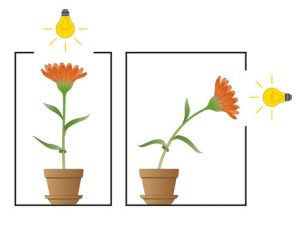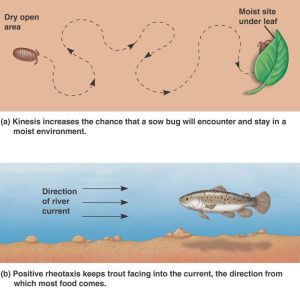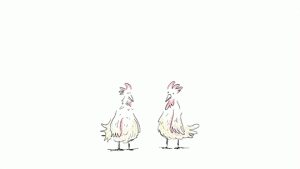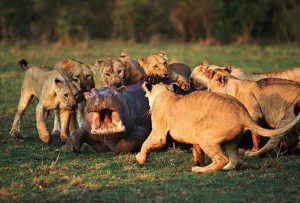
8.1 Responses to the Environment
The timing and coordination of biological mechanisms involved in growth, reproduction, and homeostasis depend on organisms responding to environmental cues. This is known as environmental sensing, which refers to the ability of organisms to detect and respond to changes in their environment. Organisms use a variety of behavioral and physiological mechanisms to sense and respond to changes in their environment, which allows them to optimize their chances of survival and reproduction (key to evolution). 🔑
Table of Contents
ToggleOrganism to Environment
One way organisms respond to changes in their environment is through behavioral mechanisms. Organisms can change their behavior in response to environmental cues, such as changes in temperature, light, or food availability. For example, migratory birds use the position of the sun and stars to navigate during their annual migration. Similarly, many insects use changes in day length to time the onset of reproduction. 🌞
Another way organisms respond to changes in their environment is through physiological mechanisms. These mechanisms involve changes in the activity of genes, enzymes, and hormones in response to environmental cues. For example, many plants change the shape of their leaves in response to changes in light intensity, which helps them to optimize their photosynthesis and avoid overheating. Similarly, many animals change the color of their skin or fur in response to changes in temperature, which helps them to regulate their body temperature.
Likewise, a number of environmental factors, such as changing temperature, weather patterns, an increase or decrease in food or water, or a decrease in shelter, can lead to changes within an organism. Many organisms are dependent on the seasons, hibernating or migrating in winter. These mechanisms and responses help them to survive and reproduce.
Examples
Photoperiodism in plants is the ability of plants to sense changes in the length of daylight and use this information to regulate growth and development. For example, many plants use the length of daylight to time the onset of flowering. Short-day plants, such as poinsettias, will only flower when the days are shorter than a certain critical length, while long-day plants, such as wheat, will only flower when the days are longer than a certain critical length.
Phototropism is the ability of plants to sense changes in the direction of light and use this information to orient their growth. For example, plants will grow towards the light to optimize their photosynthesis.

Taxis in animals refers to the ability of animals to move towards or away from a stimulus, such as light or a specific chemical. For example, many insects are attracted to light, which they use to navigate towards food sources or mates.
Kinesis in animals refers to the ability of animals to change the rate or direction of their movement in response to a stimulus, such as light or a specific chemical. For example, when a cockroach detects an unpleasant odor, it will increase its rate of movement to escape from the source of the odor.

Nocturnal and diurnal activity refer to the different patterns of activity that animals exhibit during the day and night. Nocturnal animals are active at night and sleep during the day, while diurnal animals are active during the day and sleep at night. For example, lions are diurnal animals, while bats are nocturnal animals.
Fight-or-flight response is a physiological response to a perceived threat or danger. This response is characterized by the release of adrenaline and other hormones, which prepare the body for physical activity, such as fighting or running away. This response is triggered by the activation of the sympathetic nervous system, increasing the heart rate, blood pressure, and muscle tone.

Predator warnings are the communication of danger by one organism to others of the same species. For example, when a bird spots a predator, it will emit a specific alarm call that alerts other birds in the area to the danger.
Organism to Organism: Communication is Key!
Organisms can also communicate with one another. Different species have their own highly evolved mechanisms of communication, such as the release of hormones, behavioral patterns, mating dances, warning calls, and more. ❤️

These forms of communication may be spurred by a physiological response from an organism, such as hunger or the approach of a predator. Many species communicate using verbal and nonverbal cues, involving audible warning signs and visible body language shifts. Some animal species even have communication patterns far more complex than ours.
Organisms often communicate changes they sense in their environment to protect the members of their same species. For instance, prairie dogs give a loud warning call that can be heard by their family members if a predator is approaching. While this may make them more susceptible to the predator, their genes will still be passed on by the family members that survive.
Connections to Evolution
Responses to information and communication of information are vital to natural selection and evolution. This is because the ability to sense and respond to environmental cues, as well as to exchange information with other individuals, can have a significant impact on an organism’s survival and reproductive fitness. 💪
Natural selection favors innate and learned behaviors that increase survival and reproductive fitness. For example, animals that can detect and avoid predators or find food and mates are more likely to survive and reproduce than those that cannot. Similarly, plants that can sense and respond to changes in light intensity and direction or defend themselves against herbivores are more likely to survive and reproduce than those that cannot.
Cooperative behavior also tends to increase the fitness of the individual and the survival of the population. For example, cooperative hunting, child-rearing, and care of the elderly in animals, and mutualistic relationships in plants and animals, such as pollination or seed dispersal, can increase the survival and reproduction of the individuals involved. This is because cooperation allows individuals to work together to achieve a common goal, such as obtaining food or protecting against predators, which can be more effective than working alone. 🐝

Recent Posts
- Laws of Indices – Number & Algebra – IB Mathematics AA HL
- Standard Form – Number & Algebra – IB Mathematics AA HL
- 9.2 Crafting an argument through stylistic choices like word choice and description
- 9.1 Strategically conceding, rebutting, or refuting information
- Unit 9 Overview: Developing a Complex Argument
- 8.4 Considering how style affects an argument
- 8.3 Considering how all choices made in an argument affect the audience
- 8.2 Considering how sentence development and word choice affect how the writer is perceived by an audience
- 8.1 Choosing comparisons based on an audience
- Unit 8 Overview: Stylistic Choices
- 7.4 Exploring how sentence development affects an argument
- Syllabus
- Study Guides for every class
- Short Notes
- 7.3 Examining how counterargument or alternative perspectives affect an argument
Choose Topic
- ACT (17)
- AP (20)
- AP Art and Design (5)
- AP Physics 1 (1)
- AQA (5)
- Artificial intelligence (AI) (2)
- Banking and Finance (6)
- Biology (13)
- Business Ideas (68)
- Calculator (72)
- ChatGPT (1)
- Chemistry (3)
- Colleges Rankings (48)
- Computer Science (4)
- Conversion Tools (136)
- Cosmetic Procedures (50)
- Cryptocurrency (49)
- Digital SAT (3)
- Edexcel (4)
- English (1)
- Environmental Science (2)
- Exam Updates (1)
- Finance (17)
- Fitness & Wellness (164)
- Free Learning Resources (209)
- GCSE (1)
- General Guides (40)
- Health (107)
- History and Social Sciences (152)
- IB (1)
- IGCSE (2)
- Image Converters (3)
- IMF (10)
- Math (39)
- Mental Health (58)
- News (8)
- OCR (3)
- Past Papers (463)
- Physics (5)
- SAT (39)
- Schools (3)
- Sciences (1)
- Short Notes (5)
- Study Guides (28)
- Syllabus (19)
- Tools (1)
- Tutoring (1)

